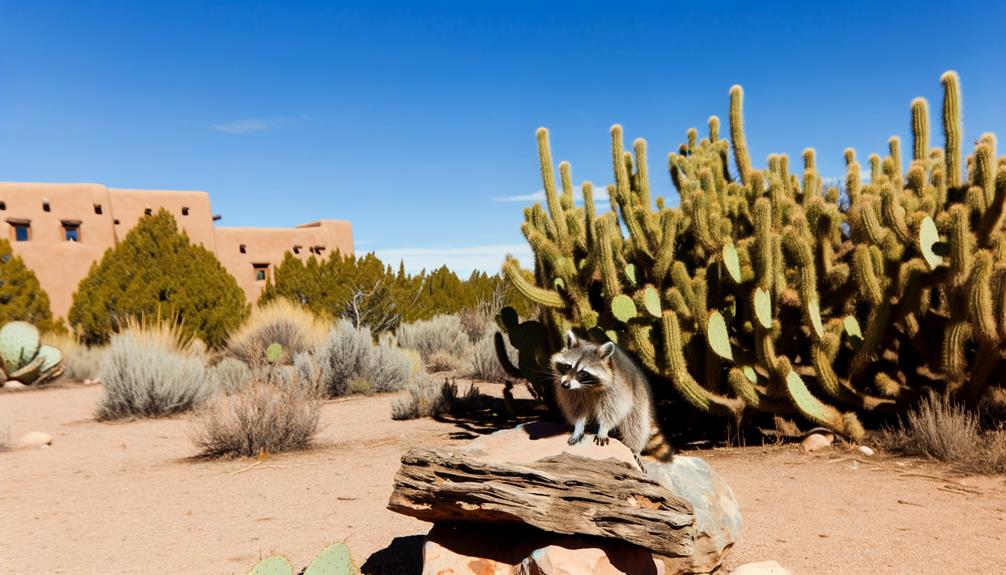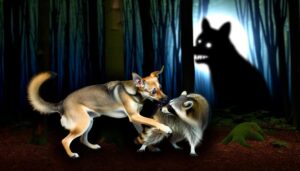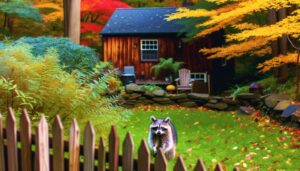How You Can Have a Pet Raccoon in New Mexico
Owning a pet raccoon in New Mexico is subject to stringent state regulations. Raccoons are classified as non-domestic animals, and prospective owners must obtain specific permits, such as Captive Wildlife or Rehabilitation permits.
The process involves applications, background checks, and possibly facility inspections to guarantee safe care. Raccoons pose risks such as zoonotic diseases like rabies and require habitats mimicking natural conditions.
Balanced diets, regular veterinary check-ups, and environmental enrichment are essential. Adhering to these rules safeguards both the raccoons and the community.
Exploring these guidelines can provide a deeper understanding of the responsibilities involved in owning a raccoon.

Key Takeaways
- Owning a pet raccoon in New Mexico requires obtaining specific permits and licenses.
- Raccoons in New Mexico are classified as non-domestic animals and subject to strict regulations.
- Permits involve applications, background checks, and sometimes inspections to ensure proper care.
- Raccoons can carry zoonotic diseases, making adherence to health protocols crucial.
- Alternatives like domesticated ferrets or dogs require less specialized care and fewer regulatory concerns.
Legal Status of Pet Raccoons
In New Mexico, the legal status of owning a pet raccoon is governed by specific state regulations and wildlife management policies. The New Mexico Department of Game and Fish classifies raccoons as non-domestic animals, subjecting them to stringent control measures. These regulations are designed to mitigate potential risks to public health, native wildlife populations, and ecological balance.
Raccoons can carry zoonotic diseases, such as rabies, which requires careful regulation. Additionally, raccoons are considered a protected species in certain contexts, necessitating adherence to conservation laws. It is crucial for individuals to understand these regulations fully to ensure compliance and contribute to broader wildlife management goals.
This framework underscores the state's commitment to safeguarding both human and animal welfare.
Permits and Licensing Requirements
To legally own a pet raccoon in New Mexico, prospective owners must obtain specific permits and licenses mandated by the New Mexico Department of Game and Fish. These permits verify that owners are capable of providing appropriate care and that the raccoons are not a threat to local ecosystems. The process involves an application, a background check, and sometimes an inspection of the living conditions.
| Permit Type | Requirements | Validity Period |
|---|---|---|
| Captive Wildlife | Application, background check | 1 year |
| Rehabilitation | Specialized training, facility inspection | 2 years |
| Educational Display | Proof of educational intent, facility check | 1 year |
| Scientific Research | Research proposal, ethical review | Project duration |
| Breeding | Genetic diversity plan, facility inspection | 3 years |
These measures safeguard the safety and welfare of both the raccoons and the community.
Health and Safety Considerations
Ensuring the health and safety of both the pet raccoon and its human caretakers necessitates a thorough understanding of zoonotic diseases, appropriate habitat conditions, and behavioral management strategies.
Raccoons can transmit diseases such as rabies, leptospirosis, and Baylisascaris procyonis (raccoon roundworm) to humans, necessitating strict adherence to vaccination protocols and regular veterinary check-ups.
Creating an environment that mimics their natural habitat reduces stress and promotes overall well-being.
Behavioral management is essential, given raccoons' inherent curiosity and potential for aggression, particularly if they feel threatened. Proper training and socialization mitigate risks associated with unpredictable behavior.
Prioritizing these health and safety considerations fosters a safer, more harmonious coexistence between raccoons and their human companions in New Mexico.
Raccoon Care and Maintenance
How can one effectively meet the full care and maintenance needs of a pet raccoon in New Mexico? Ensuring appropriate care involves several important factors.
To begin with, raccoons require a balanced diet; high-quality commercial raccoon food supplemented with fruits and vegetables is recommended.
Next, their habitat must mimic natural conditions, with ample space, climbing structures, and hiding spots.
Regular veterinary checkups are essential to monitor health and prevent zoonotic diseases.
Additionally, mental stimulation through interactive toys and environmental enrichment is essential to prevent boredom and associated behavioral issues.
Finally, maintaining a clean living environment, including regular sanitation of feeding areas and bedding, is crucial.
Alternatives to Owning a Raccoon
For individuals considering the responsibilities of pet ownership but deterred by the challenges of caring for a raccoon, there are several viable alternatives that can offer similar benefits without the associated complexities. Domesticated animals such as ferrets, hedgehogs, and sugar gliders provide engaging companionship and exhibit intriguing behaviors akin to those of raccoons. These small mammals are generally easier to manage and are legally permitted in New Mexico, reducing potential regulatory concerns.
Additionally, adopting cats or dogs from shelters may fulfill the desire for a loyal and affectionate pet while contributing positively to animal welfare. Each of these alternatives requires less specialized care, thereby making them more suitable for households seeking manageable yet rewarding pet experiences.
Conclusion
To conclude, the ownership of pet raccoons in New Mexico is governed by a labyrinth of legal stipulations, requiring adherence to permits and licensing mandates.
Health and safety considerations underscore the potential hazards of raccoon domestication, while the intricate demands of their care and maintenance challenge even the most dedicated enthusiasts.
Alternatives to owning a raccoon offer more practical avenues for animal companionship, highlighting the delicate balance between human desire and responsible stewardship of wildlife.






